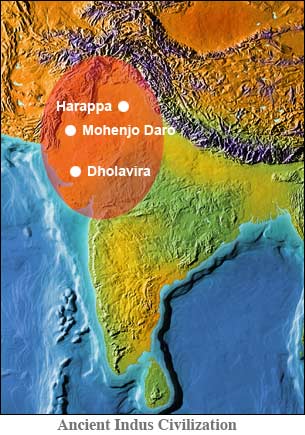THE INDUS VALLEY CIVILISATION AT LOTHAL [TEXT]
By Anil Mulchandani
Everyone knows that the Indus Valley civilization disppeared from Mohenjo-daro, but fewer know that the Harappan culture made its last stand in Gujarat province in southwestern India.
Here Indus Valley ports were set up to trade overseas with ancient Mesopotamia and Arabia along the Gulf of Combay. These ports transferred products from upriver cities along ancient Indus Valley rivers to a nascent world market.
The map in the archaeological museum of Lothal shows scores of Indus Valley sites scattered across the whole of Gujarat. Most of them occupy positions near deltas, on the banks of rivers or near the sea coast.

Around a dozen are along the Gulf of Cambay, where there is evidence that agate was mined during the Indus period. This shows how the Harappans depended on water sources for their survival and navigated rivers and sea water for trade and communication. Lothal, however, is one of the few known ports on an ocean. Lothal was originally the site for the lustrous Red Ware culture, named for its micaceous pottery. Bn 2400 BC Harappans arrived here from the Indus Valley, perhaps in search of more fertile lands and potential ports. Gradually they colonised many areas along the Gulf of Cambay, forming citadels that include the southernmost outposts of the Indus Valley civilisation.
Lothal developed as the most important port and a center of the bead industry until 1900 BC, when a great flood apparently resulted in 300 years of decline. However, the Indus civilisation survived here in the 1600s and 1500s, after which it disappeared from the northern provinces.
The result is a high maturity in town planning. The vitality of the Indus civilisation at Lothal can be judged by the 3 floods that resulted in large scale destruction, but did not dampen the ambitions of the inhabitants. Instead they breached the gaps and rebuilt the important structures on higher platforms. After the 2200 BC floods, the northwest section beyond the bazaar was enlarged further and additions were made to the ruler's palace and the merchant houses.
The first sight, that meets a visitor's eye at Lothal is the massive dockyard, which has made Lothal prominent on the international archaelogical map. Spanning an area 37 meters from east to west and nearly 22 meters from north to south, the dock was perhaps the greatest work of maritime architecture before the birth of Christ. Not all archaeologists are convinced that the structure was used as a dock and some prefer to refer to it as a large tank that may have been a reservoir.



 Around a dozen are along the Gulf of Cambay, where there is evidence that agate was mined during the Indus period. This shows how the Harappans depended on water sources for their survival and navigated rivers and sea water for trade and communication. Lothal, however, is one of the few known ports on an ocean. Lothal was originally the site for the lustrous Red Ware culture, named for its micaceous pottery. Bn 2400 BC Harappans arrived here from the Indus Valley, perhaps in search of more fertile lands and potential ports. Gradually they colonised many areas along the Gulf of Cambay, forming citadels that include the southernmost outposts of the Indus Valley civilisation.
Around a dozen are along the Gulf of Cambay, where there is evidence that agate was mined during the Indus period. This shows how the Harappans depended on water sources for their survival and navigated rivers and sea water for trade and communication. Lothal, however, is one of the few known ports on an ocean. Lothal was originally the site for the lustrous Red Ware culture, named for its micaceous pottery. Bn 2400 BC Harappans arrived here from the Indus Valley, perhaps in search of more fertile lands and potential ports. Gradually they colonised many areas along the Gulf of Cambay, forming citadels that include the southernmost outposts of the Indus Valley civilisation.